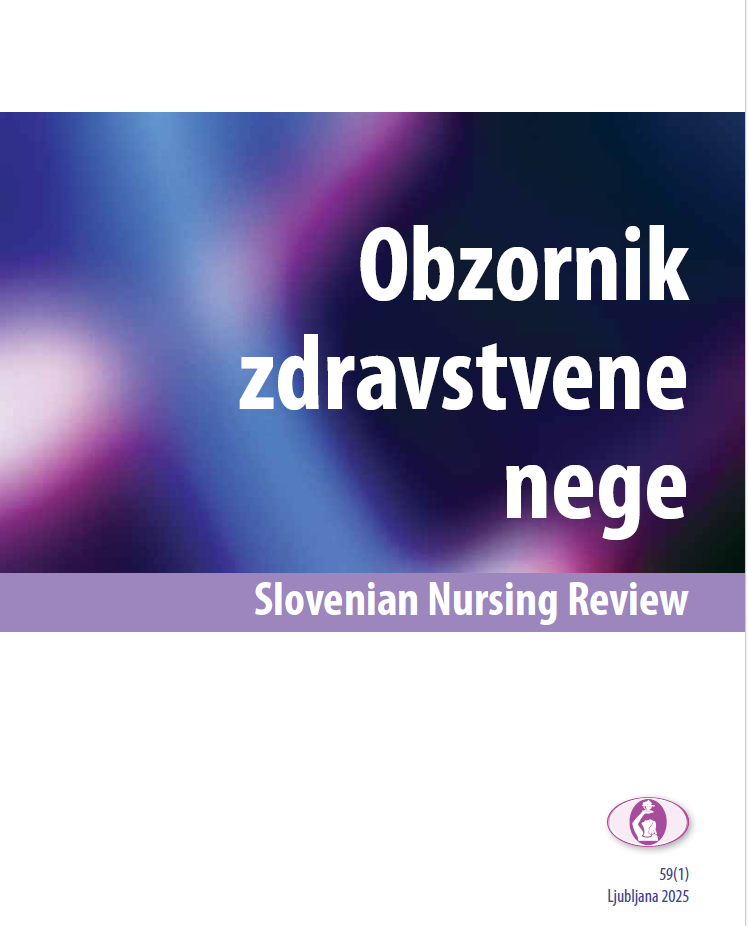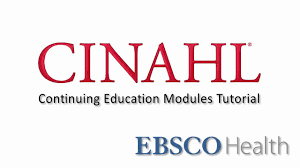Razumevanje medgeneracijskih značilnosti medicinskih sester v klinični praksi
DOI:
https://doi.org/10.14528/snr.2025.59.1.3288Ključne besede:
zdravstvena nega, delovno okolje, medgeneracijsko sodelovanje, kakovost, zadovoljstvoPovzetek
Uvod: V kontekstu globalnih sprememb in prisotnosti več generacij na delovnem mestu je razumevanje medgeneracijskih razlik ključno za zmanjšanje konfliktov in izboljšanje sodelovanja v zdravstveni negi. Namen raziskave je bil razumeti medgeneracijske značilnosti medicinskih sester v klinični praksi.
Metode: V neeksperimentalni opisni kvantitativni raziskavi je bil uporabljen v slovenski jezik preveden vprašalnik za ocenjevanje medgeneracijskih razlik v zdravstveni negi (ang. The Multidimensional Nursing Generations Questionnaire). V priložnostni vzorec je bilo zajetih 100 medicinskih sester, zaposlenih v kliničnem okolju. Podatki so bili analizirani z osnovno deskriptivno statistiko ter neparametričnimi statističnimi testi, kot so Kruskal-Wallisov test, Mann-Whitneyjev U-test in za en vzorec Wilcoxonov test.
Rezultati: Rezultati kažejo dobro usklajenost in sodelovanje med različnimi generacijami anketirancev, večjo odprtost do sprememb, večjo samostojnost in zaupanje v odločitve ter pozitivnejši odnos do dela (p<0,001). Boljše rezultate so dosegli zaposleni iz generacije X, moški, magistri stroke in zaposleni na primarni zdravstveni dejavnosti. Rezultati so pokazali, da med skupinami ni bilo statistično pomembnih razlik pri ocenjevanju razumevanja medgeneracijskih značilnosti medicinskih sester (p > 0,05).
Diskusija in zaključek: Na osnovi rezultatov smo ugotovili dobro medsebojno sodelovanje in usklajenost med različnimi generacijami medicinskih sester. Raziskava prispeva k boljšemu razumevanju dinamike medgeneracijskega sodelovanja v zdravstveni negi, kar ima potencial za izboljšanje delovnih odnosov in kakovosti oskrbe.
Prenosi
Metrike
Literatura
Ali Alferjany, M., & Alias, R. (2021). Generational differences in values and attitudes within workplace. Psychology, 57, 1496–1503. https://www.researchgate.net/publication/348930412
Anselmo-Witzel, S., Orshan, S. A., Heitner, K. L., & Bachand,J. (2017). Are generation Y nurses satisfied on the job: Understanding their lived experiences. The Journal of Nursing Administration, 47(4), 232–237. https://doi.org/10.1097/nna.0000000000000470 PMid:28333792
Batista, M., Cardoso, M., Martins, P., Lucas, P., Potra, T., Hospitalar, C., Montijo, B., & Barreiro. (2022). The involvement in the work of nurses from different generations in a hospital. Global Academic Nursing Journal, 3, Article e213. https://doi.org/10.5935/2675-5602.20200213
Behling, O., & Law, K. (2000). Translating questionnaires and other research instruments. Thousand Oaks California: SAGE Publications. https://doi.org/10.4135/9781412986373
Berkup, S. B. (2014). Working with generations X and Y in generation Z period: Management of different generations in business life. Mediterranean Journal of Social Sciences, 5(19), Article 21. http://doi.org/10.5901/mjss.2014.v5n19p218
Choi, P. P., Wong, S. S., Lee, W. M., & Tiu, M. H. (2022). Multigenerational perspectives on the competencies required of first-line nurse managers: A phenomenological study. International Journal of Environmental Research and Public Health, 19(17), Article 10560. https://doi.org/10.3390/ijerph191710560 PMid:36078279; PMCid:PMC9518487
Coburn, A. S., & Hall, S. J. (2014). Generational differences in nurses' characteristics, job satisfaction, quality of work life, and psychological empowerment. Journal of Hospital Administration, 3(5), Article124. https://doi.org/10.5430/jha.v3n5p124
Cardillo D. (2013, March). Closing the generation gap in nursing. Donna Cardillo: The inspiration nurse. https://donnacardillo.com/articles/generationgap/
Eycan, O., & Ulupinar, S. (2023). Professional attitude and selfrespect of generation X and Y nurses. Journal of Psychiatric Nursing, 14(2), 146–154. https://doi.org/10.14744/phd.2022.49344
Field, A. P. (2018). Discovering statistics using IBM SPSS statistics. SAGE Publications. Gordon, P. A. (2017). Exploring generational cohort work satisfaction in hospital nurses. Leadership in Health Services, 30(3), 233–248. https://doi.org/10.1108/LHS-02-2016-0008 PMid:28693396
Grbič, A. (2023). Izzivi medgeneracijskega vodenja v zdravstveni negi. A. Istenič (Ed.), Dimenzije kakovosti invarnosti v onkološki zdravstveni negi: 47. strokovni seminar (pp. 21–33). Zbornica zdravstvene in babiške nege – Zveza strokovnih društev medicinskih sester, babic in zdravstvenih tehnikov Slovenije, Sekcija medicinskih sester in zdravstvenih tehnikov v onkologiji. https://dirros.openscience.si/IzpisGradiva.php?id=16722
Hendricks, J. M., & Cope, V. C. (2013). Generational diversity: What nurse managers need to know. Journal of Advanced Nursing, 69(3), 717–725. https://doi.org/10.1111/j.1365-2648.2012.06079.x PMid:22775766
Janežič, D. (2022). Pregled značilnosti in analiza razlik med generacijskimi skupinami. Challenges of the Future, 7(1), 48–74. https://doi.org/10.37886/ip.2022.003
Kavšak, A., & Prosen, M. (2021). Vpliv zadovoljstva z delom na pojav izgorelosti med medicinskimi sestrami: kvalitativna opisna raziskava. Obzornik zdravstvene nege, 55(1), 7–15. https://doi.org/10.14528/snr.2021.55.1.3018
Kodeks etike v zdravstveni negi in oskrbi Slovenije in Kodeks etike za babice Slovenije. (2014). Zbornica zdravstvene in babiške nege Slovenije – Zveza strokovnih društev medicinskih sester, babic in zdravstvenih tehnikov Slovenije.
Lorber, M. (2018). A healthy work environment: Care for the well-being and health of employees in nursing. Obzornik zdravstvene nege, 52(3), 148–152. https://doi.org/10.14528/snr.2018.52.3.851
Lorber, M., Treven, S., & Mumel, D. (2015). The importance of monitoring nurses' workplace satisfaction of nurses for the well-being of all employees in nursing. Obzornik zdravstvene nege, 49(3), 182–189. https://doi.org/10.14528/snr.2015.49.3.73
Nacionalni inštitut za javno zdravje [NIJZ]. (2021). Prva objava: izvajalci zdravstvene dejavnosti 2020. https://nijz.si/podatki/prvaobjava-izvajalci-zdravacionalni inštitustvene-dejavnosti-2020/
Rollan Oliveira, S., & Siles Gonzalez, J. (2021). Nursing professionals within the intergenerational context during the 20th and 21st Centuries: An integrative review. Investigacion y Educacion en Enfermeria, 39(3), Article e14. https://doi.org/10.17533/udea.iee.v39n3e14 PMid:34822241; PMCid:PMC8912162
So Hee, L., & Yeojin, Y. (2023). Work values and communication styles among generation X, Y, and Z nurses: A cross-sectional study. International Nursing Review, 71(1), 115–121. https://doi.org/10.1111/inr.12863 PMid:37449528
Stevanin, S., Bressan, V., Vehvilainen-Julkunen, K., Pagani, L., Poletti, P., & Kvist, T. (2017). The multidimensional nursing generations questionnaire: development, reliability, and validity assessments. Journal of Nursing Management, 25(4), 287–296. https://doi.org/10.1111/jonm.12465 PMid:28164399
Stevanin, S., Palese, A., Bressan, V., Vehvilainen-Julkunen, K., & Kvist, T. (2018). Workplace-related generational characteristics of nurses: A mixed-method systematic review. Journal of Advanced Nursing, 74(6), 1245–1263. https://doi.org/10.1111/jan.13538 PMid:29424038
Stevanin, S., Voutilainen, A., Bressan, V., Vehvilainen-Julkunen, K., Rosolen, V., & Kvist, T. (2020). Nurses' generational differences related to workplace and leadership in two European countries. Western Journal of Nursing Research, 42(1), 14–23. https://doi.org/10.1177/0193945919838604 PMid:30943872
Šanc, P., & Prosen, M. (2022). Medpoklicno sodelovanje v interdisciplinarnih zdravstvenih timih: kvantitativna opisna raziskava. Obzornik zdravstvene nege, 56(1), 9–21. https://doi.org/10.14528/snr.2022.56.1.3106
Tan, S. H. E., & Chin, G. F. (2023). Generational effect on nurses' work values, engagement, and satisfaction in an acute hospital. BMC Nursing, 22(1), Article 88. https://doi.org/10.1186/s12912-023-01256-2 PMid:36997911; PMCid:PMC10061355
Yeasmin, S., & Rahman, K. F. (2012). Triangulation research method as the tool of social science research. BUP journal, 1(1), 154–163.
World Medical Association. (2013). World Medical Association Declaration of Helsinki: Ethical principles for medical research involving human subjects. Journal of the American Medical Association, 310(20), 2191–2194. https://doi.org/10.1001/jama.2013.281053 PMid:24141714
Prenosi
Objavljeno
Kako citirati
Številka
Rubrike
Licenca
Avtorske pravice (c) 2025 Obzornik zdravstvene nege

To delo je licencirano pod Creative Commons Priznanje avtorstva 4.0 mednarodno licenco.
Na Obzornik zdravstvene nege, Ob železnici 30A, 1000 Ljubljana, prenašam naslednje materialne avtorske pravice: pravico reproduciranja v neomejeni količini, in sicer v vseh poznanih oblikah reproduciranja, kar obsega tudi pravico shranitve in reproduciranja v kakršnikoli elektronski obliki (23. čl. Zakona o avtorski in sorodnih pravicah – v nadaljevanju ZASP); pravico distribuiranja (24. čl. ZASP); pravico dajanja na voljo javnosti vključno z dajanjem na voljo javnosti prek svetovnega spleta oz. računalniške mreže (32.a čl. ZASP); pravico predelave, zlasti za namen prevoda (33. čl. ZASP). Prenos pravic velja za članek v celoti (vključno s slikami, razpredelnicami in morebitnimi prilogami). Prenos je izključen ter prostorsko in časovno neomejen.
























